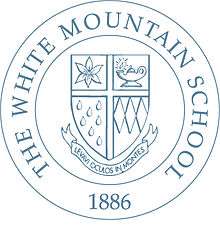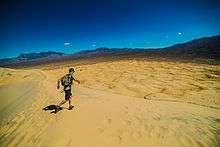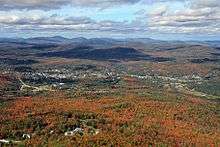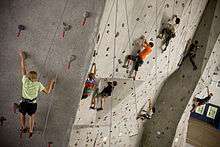White Mountain School
| The White Mountain School | |
|---|---|
 Levavi Oculos In Montes | |
| Location | |
|
Bethlehem, NH US | |
| Information | |
| Type | Private, boarding and coeducational |
| Religious affiliation(s) | Episcopalian |
| Established | 1886 |
| Head of School | Tim Breen, Ph.D. |
| Enrollment | 123 students [1] |
| Average class size | 10 [1] |
| Student to teacher ratio | 5:1 |
| Campus |
Rural 250 acres (100 ha) |
| Color(s) | Blue, White |
| Endowment | $2 million [2] |
| Website | www.whitemountain.org |
Coordinates: 44°16′49″N 71°45′30″W / 44.28028°N 71.75833°W The White Mountain School, often called White Mountain or WMS, is a co-educational, independent boarding school located in Bethlehem, New Hampshire, USA. Established in 1886 as St. Mary's School in Concord, New Hampshire, the school moved to its current location in 1936, situated just north of the White Mountains of New Hampshire.[3]
History
The White Mountain School was founded in 1886 as an all-girls Episcopal high school called St. Mary's School in Concord, New Hampshire. In 1935, Dorothy McLane, the school's headmistress, moved the school north into the White Mountains region, to the estate of Ernest Poole in Sugar Hill, New Hampshire; the school was then renamed St. Mary's-in-the-Mountains. One year later in 1936, the school bought the Seven Springs Estate, in Bethlehem, New Hampshire, from Eman and Mary Payne Beckits and relocated there for the last time. Over the next 25 years, the Bethlehem campus expanded with the purchase of new dormitories and the construction of new classroom wings. On January 3, 1964, the school's Main Building burned down. The following year, a new Main Building was constructed in its place. Six years later, in 1970, the school began accepting a small number of male day students, and in 1972 the school became co-educational and changed its name to The White Mountain School.[4]
Academics
The White Mountain School curriculum is structured in a traditional liberal arts model. Each discipline offers a range of courses from introductory-level, Honors, Advanced Placement, to student-designed independent studies. Year-long courses are worth one credit; semester courses are worth ½ credit. To graduate, students must earn 19 academic credits, including a minimum of 4 credits in English, 2 ½ credits in history, 3 credits in mathematics, 3 credits in science, 2 credits in world language, 1 credit in the arts, ½ credit in philosophy and religious studies and ½ credit in sustainability studies. (The White Mountain School was the first high school in the US to add Sustainability Studies as an academic department.)[5] In addition, students must complete two Field Courses per year and a LASR Project.[6]

The White Mountain School Field Course is a week-long, academic exploration of a specific topic that occurs within an appropriate geographic setting. They occur in October and March for five days in length, although international Field Courses are longer. Recent courses have included Poverty, Homelessness and Hunger (Portland, Maine), Adirondack Art and Adventure (New York), Island Culture and Ecology (Acadia National Park, Maine), Avalanche Forecasting (Wyoming & Idaho), A Walk in Thoreau's Shoes (Massachusetts), Gender & Politics: Women's Rights in the US (Washington, DC), Desert Ecology of the Southwest (Tucson, Arizona), Community Service Odyssesy (Dominican Republic), Writing for Performance: Exploration of Performing Arts (New Hampshire), Buddhism (The Vermont Zen Center, Shelburne, Vermont), Green Living in the Urban World: Sustainability & Service (Montreal, Canada), Carving Up Equations to Carve the Slopes: The Math of Ski and Snowboard Design (Vermont & New Hampshire).[7]
"LASR" in The White Mountain School LASR Project stands for the general categories that students can pursue: Leadership, Arts, Service and Research. Students choose from several approaches to completing the project, including (but not limited to) the following courses: Research Seminar, Art Portfolio, Independent Study, Senior Project, and Field Course Leadership.[7]
Faculty and advisors
Every student has a faculty advisor who communicates with parents throughout the year and they serve as a primary liaison between student, family, and teacher.[8] 67% of the faculty hold advanced degrees as well as a variety of additional certifications.[1]
College matriculation
Recent WMS graduates have attended colleges and universities that include American University, Boston University, Colby College, Connecticut College, Davidson College, Drexel University, Duke University, Mount Holyoke College, New York University, Tufts University, the University of Michigan, the University of New Hampshire, and Wesleyan University.[9]
Student body
The White Mountain School enrolls 123 students from around the country and the world, 49% male and 51% female.[1] 76% of the student population boards and 24% are day students from surrounding towns.[1]
Campus

The school's 250-acre (100 ha) campus is located between the towns of Bethlehem and Littleton, New Hampshire on a hilltop providing views of the White Mountains. The McLane Academic Center houses the classroom wing, multimedia center and learning labs. The school library offers more than 7,000 volumes, an online catalog, several online databases, and an inter-library loan system with Dartmouth College and the University of New Hampshire. The Fred Steele Science Center is equipped with SMART Board interactive technology and state-of-the-art labs which allow for a wide range of independent projects. The new Catherine Houghton Arts Center houses dance, visual arts, and music studios. The school partners with Creative Edge Dance Studio to offer academic courses as well as technique and performance-based classes for students of all dance styles and levels.[10][11] Students have access to these spaces and the practice studios and recording lab outside of class.
The 3,000-square-foot (280 m2) indoor Beverly S. Buder climbing wall is located inside an indoor sports center outfitted with Nautilus equipment, free weights and aerobic equipment. The campus also has two athletic fields, an extensive trail system, and a school farm, including a student-built post and beam shed; a chicken coop with hens; an organic vegetable and fruit garden; and composting bins. The student center is located in McLane.
Boarding students live in one of four dorms with their peers, faculty members and faculty families. Each dorm has common space with couches, a TV and a microwave. The dining hall serves breakfast, lunch, and dinner, and is available for drinks and light snacks all day.[12]
On weekends, faculty offer a range of activities for students. Activities include outdoor outings such as moonlight hikes, ski trips or mountain bike riding; shopping trips to outlet centers, Burlington, or the local towns; art excursions to movies, plays, and art exhibits; campus sponsored cultural events, cookie baking in faculty kitchens and games.[12]
Arts and athletics


Students participate in afternoon activities each season of the year and can choose from a variety of recreational and interscholastic sports.[13]
|
Fall
|
Winter
|
Spring
|
The White Mountain School's rock climbing program was the first high school program to earn accreditation from the American Mountain Guides Association (AMGA). The sport climbing program partners with USA Climbing to provide multiple opportunities for competition. Students who choose to pursue outdoor sports learn the technical aspects of climbing and explore topics as minimum-impact travel, first aid, navigation, orienteering, trip planning, and natural history.
Extracurricular opportunities
Extracurricular opportunities vary from year to year, depending upon the interests of the student body. Current clubs include a cappella, art club, astronomy club, chess club, Citizenship Committee, diversity club, electronics club, National Honor Society, photography club, robotics club, Social Committee, Spectrum Alliance, step club, Student Council, sustainability club and frisbee club.[14] The yearbook, “The Pendulum,” is designed and produced by students, as well as "Ink and Paper," the student-published literary and arts magazine.[15] Students interested in the performing arts perform in a cappella, dance and theater productions, and informal coffee houses. With a focus on international song and dance, the school brings professional performers and artists to campus for community dinners.
Students have opportunities to participate in community service at local events on the weekend as well as through trips within the U.S. and abroad e.g. Dominican Republic and Nicaragua. In addition, community service is offered as a winter sports option. All students, teachers and administrators participate in on-campus service through the Work Jobs Program. Duties include kitchen crew, recycling, or helping in the library. In addition to their campus jobs, all boarding students have rotating job assignments in their dormitories.[16]
Costs and financial aid
Tuition, room and board for 2016-2017 is $57,900. Day student tuition is $29,000. Learning Center tutorials and the ESL Program have additional fees. 40% of students receive financial aid, with an average award of $40,000. Eligibility is based on need as established by School and Student Services (SSS) by National Association of Independent Schools.[1]
Notable alumni
- Parker Croft '05, film actor and screenwriter, known for Falling Overnight and Once Upon a Time (TV series)
- Will Gadd '85, renowned ice climber and paraglider pilot
- Caroline Cheng '81, artist and director of the Pottery Workshop[17]
- Bret Arsenault '80, Vice President and Chief Information Security Officer (CISO) at Microsoft Corporation[18]
- Ellen Waterston '64, author and founder of Writing Ranch[19]
- Audrey Thomas '53, novelist and short story writer, three time recipient of the Ethel Wilson Fiction Prize
- Lucile Wheeler '52, Olympic skier, first North American to win a world title in the downhill event
External links
References
- 1 2 3 4 5 6 "TABS - School Profile". The Association of Boarding Schools. The Association of Boarding Schools. Retrieved 4 November 2014.
- ↑ "White Mountain School:Giving". The White Mountain School. Retrieved August 4, 2009.
- ↑ "History". The White Mountain School. The White Mountain School. Retrieved 4 November 2014.
- ↑ "History". White Mountain School. Retrieved July 26, 2009.
- ↑ "Curriculum". The White Mountain School. The White Mountain School. Retrieved 26 November 2014.
- ↑ D'Arco, Linda. "WMS Course Guide". Issuu. Issuu. Retrieved 4 November 2014.
- 1 2 D'Arco, Linda. "WMS Course Guide". Issuu. Issuu. Retrieved 4 November 2014.
- ↑ "Advising". The White Mountain School. The White Mountain School. Retrieved 4 November 2014.
- ↑ "TABS - School Profile". The Association of Boarding Schools. The Association of Boarding Schools. Retrieved 4 November 2014.
- ↑ "Performing Arts". The White Mountain School. The White Mountain School. Retrieved 5 November 2014.
- ↑ "The White Mountain School Connection". Creative Edge Dance Studio. Creative Edge Dance Studio. Retrieved 5 November 2014.
- 1 2 "Residential Life". The White Mountain School. The White Mountain School. Retrieved 4 November 2014.
- ↑ "Teams". The White Mountain School. The White Mountain School. Retrieved 4 November 2014.
- ↑ "Clubs and Activities". The White Mountain School. The White Mountain School. Retrieved 4 November 2014.
- ↑ "Ink and Paper". The White Mountain School. The White Mountain School. Retrieved 4 November 2014.
- ↑ "Frequently Asked Questions". The White Mountain School. The White Mountain School. Retrieved 4 November 2014.
- ↑ ajc. "Caroline CHENG". www.ajc-art.com. Retrieved 2016-03-28.
- ↑ "The White Mountain School: Echoes Winter 2015". Issuu. Retrieved 2016-03-28.
- ↑ "About Author/Founder Ellen Waterston". The Writing Ranch. Retrieved 2016-03-28.